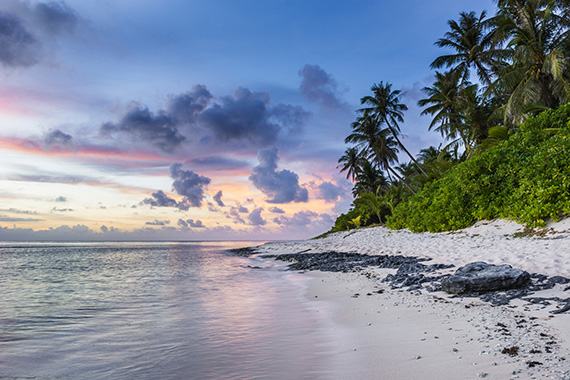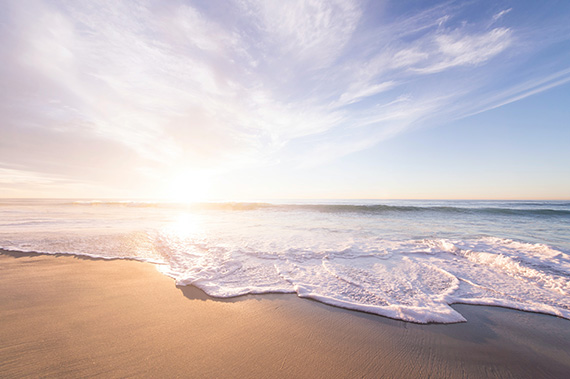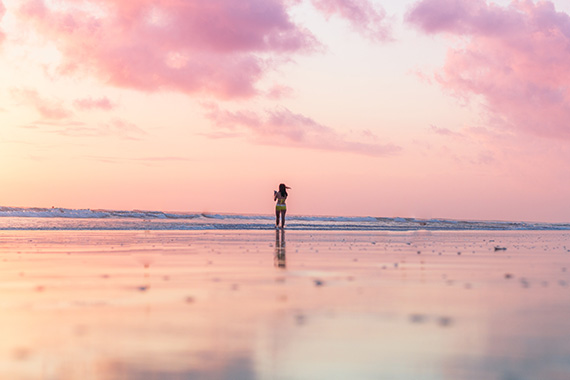Nature photographers, landscape photographers, wedding photographers, hobby photographers… who doesn’t love an excuse to take some photos at the beach? It is human nature to want to take photos of the places we are drawn to personally, so the beach is a great source of inspiration for photographers at all levels. Beach photography can be particularly challenging, even for experienced nature photographers. We are often inspired by the sounds, the smells, the open space; so the job of the photographer is not just to photograph a place, but to capture a feeling.

Photo by Andrew Coelho
This can make beach photography a deeply personal thing, so your approach to a photo will be guided by what that location means to you. However, there are some easy ways to add impact to your pictures. Here are five simple tips to help you enjoy your next beach photography outing.
Beach Photography Tip #1. Time of Day. Every landscape photographer knows that early in the morning and late in the afternoon are the best times for taking outdoor photos. At these times the natural light is tinged with warm colour, and the contrast is low for a much more attractive effect. Shining from a much lower angle, the sunlight illuminates most subjects softly and evenly.
This rule definitely applies at the beach, especially wherever there is white sand. If you take your photos in the middle of the day, the glare from the sand and the white water will create stark, high-contrast photos that will not do justice to the location. However, when the sun is low it will illuminate the entire scene with much warmer colours. The froth at the waters edge will light up like champagne bubbles, and the whole photo will be richer and more atmospheric.

Photo by Frank McKenna
Beach Photography Tip #2. Get Down To The Water’s Edge. To get the best beach photos, be prepared to get your feet wet. Down at the water’s edge where the sand is wet, your foregrounds will be more colourful, and wiped clean of footprints, tyre tracks and other distractions that can spoil the natural look of a beach photo. You may also discover reflections that add interest to otherwise plain foregrounds.
Beach Photography Tip #3. Find An Eye-Catching Feature. A long, empty expanse of white sand with a clear blue sky is perfect for a walk on the beach, but can be too empty and plain for a photograph. You should try to find a feature to build your composition around. Many beaches have a rocky headland at each end; head for the rocks to find a more interesting foreground. Not only will your photos have a stronger focal point; they will also have more appeal for viewers who can identify familiar features in the image.
Once you start looking, there are all types of features on a beach that can add interest to your composition; driftwood, shells, rocks, lifesavers’ flags…just be creative and the list is endless.
Beach Photography Tip #4. Make The Most Of A Good Sky. A clear blue sky at the beach can be a thing of beauty – and can also be a photographer’s worst enemy. A great cloud formation can add a whole new dimension to your photo, especially if you can’t find anything of interest in the foreground.
Even if it quite overcast, don’t despair. With patience and luck, you may encounter sunbeams radiating across the water as the sun rises or sinks behind the clouds. Remember that beach photos don’t always have to be bright and sunny. We see enough of that in advertising and the movies. The photos that stand out from the crowd are often the ones with dark skies and brooding atmosphere, not white sand and blue sky.

Photo by Resa Cahya
Beach Photograhy Tip #5. Use Your Wide Angle Lens. A wide-angle lens can be the best way to capture that sense of isolation and distance that you often feel when walking on the beach. The smaller lens exaggerates the perspective, making the background appear to stretch away for many miles and creating a real sense of three-dimensional depth. If you are looking up the beach, you can capture everything from the swirling water right in front of you to the lighthouse in the distance. Even better, the stronger depth of field of the wide-angle lens lets you keep it all in focus.
This ‘wide-open-spaces’ effect can look plain and empty if your scene lacks features, so remember Tips #3 and #4 and make the most of your skies and foregrounds. Obviously the wide-angle lens is not the best option for every photo, but it not a bad place to start if you are looking for ideas.
So there you have my five simple tips for beach photography. This is by no means a comprehensive guide. As with all nature photography, beach photography is an adventure that never ends. You never get tired of taking photos, and you never take two photos quite the same. Still, if this little article encourages you to get out there and practice, then you are one step closer to becoming a better photographer.
About the Author:
Andrew Goodall writes for http://www.naturesimage.com.au and is a nature photographer based in Australia. He manages a gallery in Montville full of landscape photography from throughout Australia.
Go to full article: Photography: Five Tips For Great Beach Photos
What are your thoughts on this article? Join the discussion on Facebook
PictureCorrect subscribers can also learn more today with our #1 bestseller: The Photography Tutorial eBook
The post Photography: Five Tips For Great Beach Photos appeared first on PictureCorrect.
from PictureCorrect https://ift.tt/3uit1KN
via IFTTT






0 kommenttia:
Lähetä kommentti